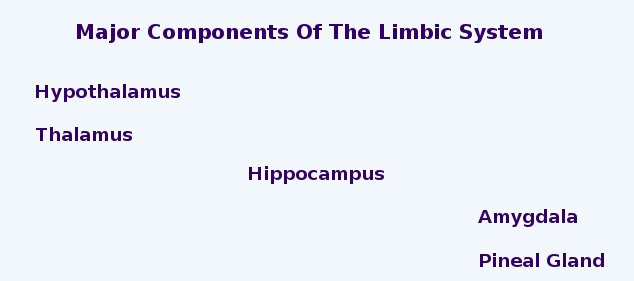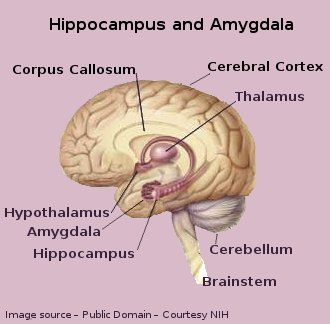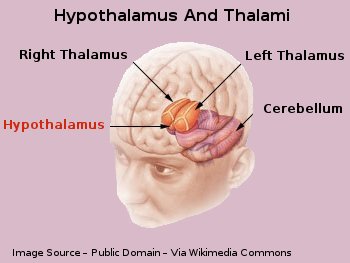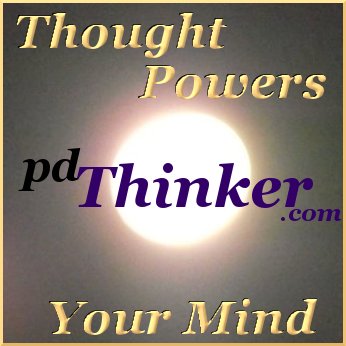Your Limbic System
The Driving Force
Of Your Very Existence
Part 5 - Part 4
You Are Your Limbic System
Our Limbic System is necessarily involved in just about everything that defines us as both living creatures and individual Human Beings.
Encircling the Brainstem, the Limbic System is itself encompassed by the Cerebrum.
Complex, complicated, and intricate, it is responsible for we Humans displaying complicated and intricate traits.
The term Limbic is a collective name for a cluster of important components - not that there is anything in the Brain that is not important - which we utilize to define ourselves as individuals.
Sometimes referred to as the Midbrain, owing to it's location, it should not be confused with the Midbrain that is part of the Brainstem.
The frequently overburdened Limbic System kindly furnishes the Stage for the Emotional State of Mind an individual presents to the World in daily life. This simply means our moment by moment Mood via our Attitude.
In addition to this demanding task, the Limbic System enables us to be warm blooded and cuddly creatures in a purely physical sense. Doing so by regulating Body Temperature
Perhaps just a touch more significant, cooperating in Harmony with the Medulla Oblongata, this impressive system keeps us alive and ticking. Dutifully overseeing a host of involuntary functions few of us rarely give a second Thought to.

Hypothalamus
Demonstrating that size is not always relevant, the diminutive Hypothalamus shoulders a huge workload in fulfilling the role of being your body's Homeostasis executive.
The tiny Hypothalamus regulates Thirst, Emotions, Hunger, Reproduction, Temperature, and Sleep.
In additional, this willing Organ shares responsibility for administering several Involuntary functions.
Involuntary functions include Digestion, Heartbeat, Blood Pressure, Breathing, and Sweating.
The Hypothalamus executes it's responsibilities via the Autonomic Nervous System, and the Hormones produced by the Pituitary Gland, the body's Master Gland. Hormones are distributed via the Endocrine System.
Fair dinkum!! Never again will I whine about having too much to do!!
Thalami
Illustrated in the above image the Thalami function as the Body/Brain Communications Hub.
Composed of Gray Matter in the form of Nuclei, the Thalami are located almost centrally in the base of both Hemispheres.
The Thalami communicate with every Sensory System except for the Olfactory, (sense of smell) and have a web of connections to and from the Cerebral Cortex and many other Brain regions. Including the feisty Amygdala and Basal Ganglia.
Like a super efficient receptionist in an active office, the Thalami accept all incoming signals (excluding Smell) from the Sensory Systems and redistributes these signals to the related region of the Cerebral Cortex, where voluntary action originates.
Recent research links the Thalami to Consciousness. And there is good reason to speculate that these two influential Organs are implicated in Cognitive processing.
Thalami is plural for Thalamus.
Hippocampus

The Hippocampus, one located in each of the Cerebral Hemispheres, compose part of one of the Evolution's early subsystems of the Brain. Known as the Hippocampal Formation.
Believed to be involved with Emotional and Factual Memory Production and performing the establishment of short term Memories into long term, to be permanently stored in the Neocortex.
The Hippocampus itself is composed from Cortical Tissue.
Additional responsibilities are believed to be contributions to Learning, and also Spacial Navigation. Mine does not work too good in shopping centers. Without the Missus holding my hand, I easily get lost.
Amygdala
While Deeply involved in Emotions, positive and negative, but in particular the Emotions of fear and aggression, the Amygdala appears to play a role in emotionally charged Memory retention.
Supercharging Memories with Emotion happens to be the best way to remember anything.
It could also be our early warning system, alerting the individual to possible physical danger before it happens.
The Amygdala is closely associated with the Olfactory System and like the Thalamus, it is well connected to the Cerebral Cortex and other Brain regions.
Pineal Gland
The primary role of the Pineal Gland is the production of Melatonin, the Hormone involved in Circadian Rhythms.
Circadian is the twenty four hour Biological Cycle, influencing sleep/wake ratio, shared by many living organisms.
This tiny, essential, Organ, has been linked to the Reproduction System and also to the Immune System.
The Pineal Gland, while no longer directly Photosensitive in Humans, as once believed to be, is still sensitive to light, and works in close association with the Retina.
Summary
To develop a machine to exhibit high
performance, it is necessary to know and understand what all the components
do, and their relationship to each other.
Appreciating this understanding enables you to modify and refine your Inner Machine. Adapt, edify, and ameliorate, as does fine Wine. Doing so, until you have accomplished the optimum Harmony between the Components, Subsystems, Systems, and finally, Machine, that you are capable of reaching.
Optimum Harmony equals optimum Power, Effectiveness, and Efficiency.
From the individual Human perspective, this modifying, and refining, belongs to the dominion of wise Personal Development. Influencing the Limbic System plays a major role.
Your Limbic System Rocks!
Part 5 - Part 4








